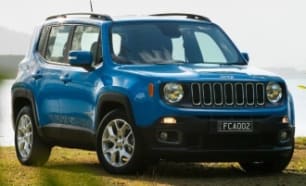It's certainly an experience, but the Gladiator is not as atrocious on-road as you may assume.
This vehicle is a lot of fun to drive because it demands a lot of attention and input to keep it on target.
The steering is floaty, with plenty of play in the wheel and understeer through corners, and there's a fair bit of tyre rumble from the BFG muddies.
The wing mirrors generate noticeable wind noise, but the Gladiator's not as awkward or unrefined as you might expect.
Because it's essentially a stretched Wrangler – with a 787mm longer body and a 480mm longer wheelbase than its stablemate – the Gladiator has a solid stance on the road and, for such an unashamedly off-road-oriented vehicle, it feels even more settled and composed than the Wrangler does on sealed surfaces.
This 2242kg ute is built for tough fun with a body-on-frame design and reinforced chassis, but the Gladiator manages to be nimble around town.
Ride quality is generally impressive with this ute cruising comfortably on live axles front and rear with coil springs and, in 2023 onward versions, Tenneco shocks all-around rather than the previous Fox Shocks set-up.
Aspects of the Gladiator experience will annoy some people. Visibility is compromised in all directions, the throttle is touchy, the 13.6m turning circle may add a degree of difficulty in attempts at fast turnarounds (on a city street or in a busy country pub car park) and all that driver attention and input the Gladiator demands of its steerer will become tiresome for a few drivers.
But, as expected, the Gladiator's true spirit is only ever fully revealed when you head off-road. It's a hell of a lot of fun in the dirt. Drop tyre pressures, do up your seat belt and let the Gladiator off the leash.
The 'Trail Rated' Gladiator is loaded with off-road mechanicals, from a 4X4 system with 4:1 low-range (contributing to a 77.2:1 crawl ratio), front and rear diff-locks, heavy-duty Dana 44 axles (front and rear), sway-bar disconnect and BFGoodrich Mud Terrain tyres, as well as a stack of driver-assist tech aimed at making you feel like Australian 4WD expedition legend Ron Moon.
Shocks engineered for off-roading add a welcome dimension of comfort and handling to the Gladiator on fast dirt and gravel tracks on the way to your chosen off-roading destination.
That 77.2:1 crawl ratio means nothing to most of us until you have the opportunity to experience the feeling of all that terrain-gripping torque for yourself.
In 4WD low-range first gear, and with both diffs locked, the Gladiator feels unstoppable. It climbed with ease a short steep rocky hill where I've seen drivers of modified vehicles opt for the ‘chicken' tracks either side.
The only thing is, because of the Gladiator's 3488mm-long wheelbase and 18.4-degree ramp-over angle, there's a real risk of bellying out or at least grinding the undercarriage on earth when you crest these steep hills, which is why you must drive with concentrated focus.
But that's part of the fun. It really is a driver-direct experience. You need to be aware of everything that's going on, you never feel like you're one step removed from the situation, or the terrain or the consequences of your driving… you feel dialled into the terrain and that's guaranteed to put a smile on any 4WD enthusiast's face.
Besides, the Gladiator does have substantial underbody skid-plates, protecting the fuel tank, transmission and transfer case, as well as heavy-gauge tubular steel rock rails to soak up off-road hits.
With an approach angle of 40.7 degrees, a departure angle of 25.1 degrees and a listed ground clearance of 249mm and a wading depth of 760mm, the Gladiator has decent off-road measures.
Suspension travel is okay, but to get even more stretch, you can hit the sway-bar disconnect button to drop a wheel to the dirt – or as close as possible depending on how deep the ruts are.
The Gladiator has 'Selec-Speed Control' (effectively an adjustable low-speed cruise control for 4WDing that can be set between 1.0-8.0km/h), and 'Off-Road+', which tweaks throttle and traction control, among other systems, to best suit the terrain.
It also has a forward-facing off-road camera so the driver has a chance to see any obstacles that might otherwise go unnoticed until it's too late, such as branches, rocks, tree stumps and hard rubbish.

